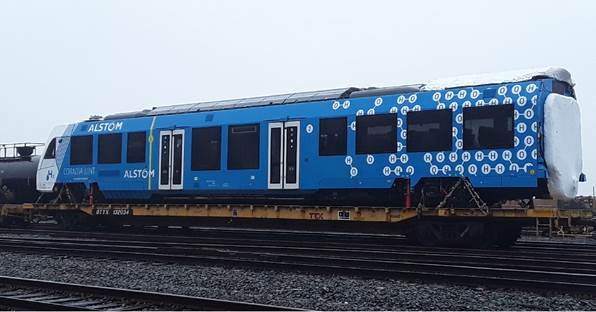A hydrogen passenger train for Nova Scotia?
Larry Hughes
Published in allnovascotia.com 19 April 2024
Over the past week or so, if you had looked in the railyard just across from Mount Saint Vincent University you would have seen what appeared to be a pair of blue-and-white passenger rail carriages sitting atop two flat cars.
If you had looked a bit closer, you would have seen that the carriages were actually a pair of hydrogen powered railcars, the Coradia iLint, built by Alstom (the giveaway were the symbols H-O-H, O-O, and H-H representing water, oxygen, and hydrogen, respectively, on the end of each railcar).

One of the hydrogen railcars in Halifax (Larry Hughes)
The railcars are on their way back to Germany after spending part of the past year in Québec.
Why Québec?
In addition to Alston having its North American headquarters in Saint-Bruno-de-Montarville (a suburb of Montreal) and attempting to curry favour with Québec Premier Legault, Alston had access to a short-line railway and a source of hydrogen.
The short-line railway is operated by Chemin de fer Charlevoix, carrying freight and, during the summer months, tourists. The line is about 144 km long, running from Québec City to La Malbaie along the north shore of the St. Lawrence River.
The hydrogen for the project was supplied by Harnois énergies, an energy supplier and distributer based in Québec. Harnois produces green hydrogen in Québec City with electricity supplied by Hydro Québec.
The hydrogen railcars ran from Montmorency Falls outside Québec City to Baie-Saint-Paul, a distance of about 90 kilometres. The train could not run from Baie-Saint-Paul to La Malbaie because of the track curvature.
Between June and September last year, the train carried more than 10,000 customers. It was the first commercial hydrogen passenger service in North America.
Why not Nova Scotia?
According to Premier Houston, "Nova Scotia is poised to be a world leader in the production of green hydrogen... that will bring benefits to Nova Scotians for generations to come".
One of the indirect benefits of the premier's green hydrogen plan could be tourism.
This summer, Halifax is expecting about 190 cruise ships. Many of the visitors want to see sites such as Grande Pré and wineries in the Annapolis Valley. Those who do make the trip are transported by bus.
If the experience in Québec is anything to go by, a green-hydrogen tourist train would certainly be popular amongst a segment of the cruise ship visitors and other tourists visiting the province.
Since Piers 20 and 22 are both near the Via station it would be a natural starting location.
The line, such as it is, runs as far as Windsor. If the line was upgraded by CN, passengers could be transported to the Valley from Windsor.
If the line was upgraded and tracks re-laid from Windsor to Wolfville, the passengers would be close to many of the wineries and other tourist sites.
If EverWind starts producing green hydrogen in late 2025 or early 2026 as planned, the train service could begin operation in 2026.
The distance from Halifax to Wolfville is about 90 kilometres, about the same as the line in Québec. Since the trip to the Valley would be emissions free, if the tourist buses in the Valley ran on hydrogen, the entire experience would be emissions free.
Clean transportation, innovative technology, increased tourism, and reduced emissions because of Nova Scotian hydrogen, all things that should interest the premier.